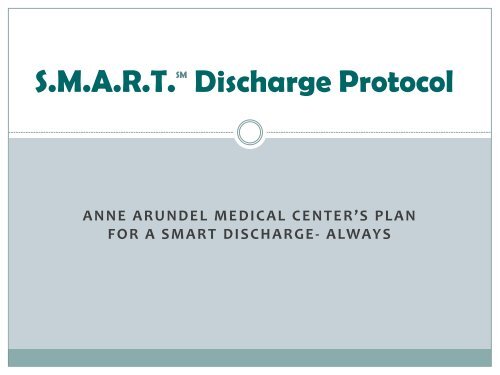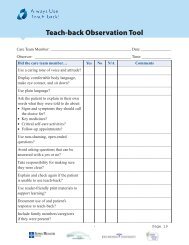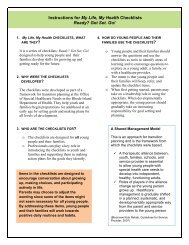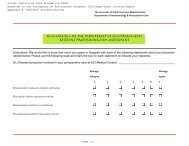S.M.A.R.T.SM Discharge Protocol - Always Events - Picker Institute
S.M.A.R.T.SM Discharge Protocol - Always Events - Picker Institute
S.M.A.R.T.SM Discharge Protocol - Always Events - Picker Institute
Create successful ePaper yourself
Turn your PDF publications into a flip-book with our unique Google optimized e-Paper software.
S.M.A.R.T. <strong>SM</strong><br />
<strong>Discharge</strong> <strong>Protocol</strong><br />
ANNE ARUNDEL MEDICAL CENTER’S PLAN<br />
FOR A <strong>SM</strong>ART DISCHARGE- ALWAYS
Housekeeping<br />
• Please silence or turn off cell phones<br />
• Participants must attend the entire session to<br />
receive MNA contact hours<br />
• MNA certificates will be distributed as evaluations<br />
are turned in at the end of the session<br />
• This presentation is co-sponsored by <strong>Picker</strong><br />
<strong>Institute</strong>
<strong>SM</strong>ART discharge video
Core Concepts of<br />
Patient and Family Centered Care<br />
RESPECT & DIGNITY: WE, AS PRACTITIONERS, LISTEN TO AND HONOR<br />
PATIENT AND FAMILY PERSPECTIVES AND CHOICES.<br />
INFORMATION SHARING: PRACTITIONERS COMMUNICATE AND SHARE<br />
COMPLETE AND UNBIASED INFORMATION WITH<br />
PATIENTS AND FAMILIES IN WAYS THAT ARE<br />
AFFIRMING AND USEFUL.<br />
PARTICIPATION: PATIENTS AND FAMILIES ARE EMPOWERED AND<br />
SUPPORTED TO PARTICIPATE IN CARE AND DECISION<br />
MAKING AT THE LEVEL THEY CHOOSE.<br />
COLLABORATION: PATIENTS, FAMILIES, PRACTITIONERS, AND HEALTH<br />
CARE LEADERS COLLABORATE IN THE ONGOING<br />
DESIGN, DEVELOPMENT AND IMPLEMENTATION OF<br />
POLICIES AND PROGRAMS.
MSU POP QUIZ<br />
•How many patients were discharged from Jun-Aug 2011<br />
855<br />
•How many were seen in the ER<br />
126<br />
•How many were readmitted<br />
125
MSU's % of "<strong>Always</strong>" Responses to the HCAHPS Question on Staff Telling What<br />
New Medicines Were for Before Giving with options of <strong>Always</strong>, Usually,<br />
Sometimes or Never<br />
100.0%<br />
90.0%<br />
80.0%<br />
% "<strong>Always</strong>" Responses<br />
70.0%<br />
60.0%<br />
50.0%<br />
40.0%<br />
30.0%<br />
20.0%<br />
10.0%<br />
0.0%<br />
Jan - Mar<br />
2009<br />
Apr - Jun<br />
2009<br />
July - Sep<br />
2009<br />
Oct - Dec<br />
2009<br />
Jan - Mar<br />
2010<br />
Apr - Jun<br />
2010<br />
July - Sep<br />
2010<br />
Oct - Dec<br />
2010<br />
Jan - Mar<br />
2011<br />
Apr - Jun<br />
2011<br />
MSU 81.3% 73.3% 70.4% 84.2% 75.0% 84.0% 73.7% 88.9% 62.5% 67.6%<br />
MSU Benchmark 72.5% 72.5% 74.1% 74.1% 74.1% 74.1% 73.8% 73.8% 73.8% 73.8%
MSU's % of "<strong>Always</strong>" Responses to the HCAHPS Question on Staff Describing<br />
Possible Side Effects of New Meds with options of <strong>Always</strong>, Usually,<br />
Sometimes or Never<br />
100.0%<br />
90.0%<br />
80.0%<br />
% "<strong>Always</strong>" Responses<br />
70.0%<br />
60.0%<br />
50.0%<br />
40.0%<br />
30.0%<br />
20.0%<br />
10.0%<br />
0.0%<br />
Jan - Mar<br />
2009<br />
Apr - Jun<br />
2009<br />
July - Sep<br />
2009<br />
Oct - Dec<br />
2009<br />
Jan - Mar<br />
2010<br />
Apr - Jun<br />
2010<br />
July - Sep<br />
2010<br />
Oct - Dec<br />
2010<br />
Jan - Mar<br />
2011<br />
Apr - Jun<br />
2011<br />
MSU 38.5% 60.0% 50.0% 55.6% 36.4% 52.0% 52.6% 44.4% 25.0% 47.1%<br />
MSU Benchmark 46.3% 46.3% 45.3% 45.3% 45.3% 45.3% 45.5% 45.5% 45.5% 45.5%
100.0%<br />
MSU's % of "<strong>Always</strong>" Responses to the HCAHPS Question on Nurses Listening<br />
Carefully, with options of <strong>Always</strong>, Usually, Sometimes or Never<br />
90.0%<br />
80.0%<br />
% "<strong>Always</strong>" Responses<br />
70.0%<br />
60.0%<br />
50.0%<br />
40.0%<br />
30.0%<br />
20.0%<br />
10.0%<br />
0.0%<br />
Jan - Mar<br />
2009<br />
Apr - Jun<br />
2009<br />
July - Sep<br />
2009<br />
Oct - Dec<br />
2009<br />
Jan - Mar<br />
2010<br />
Apr - Jun<br />
2010<br />
July - Sep<br />
2010<br />
Oct - Dec<br />
2010<br />
Jan - Mar<br />
2011<br />
Apr - Jun<br />
2011<br />
MSU 80.0% 82.9% 76.7% 75.0% 72.0% 68.5% 74.3% 75.0% 79.2% 82.8%<br />
MSU Benchmark 74.0% 74.0% 73.4% 73.4% 73.4% 73.4% 74.2% 74.2% 74.2% 74.2%
MSU's % of "Yes" Responses to HCAHPS Question on Talking to Patients About Help<br />
After <strong>Discharge</strong> with options of Yes or No<br />
100.0%<br />
90.0%<br />
% "Yes" Responses<br />
80.0%<br />
70.0%<br />
60.0%<br />
50.0%<br />
40.0%<br />
30.0%<br />
20.0%<br />
10.0%<br />
0.0%<br />
Jan - Mar<br />
2009<br />
Apr - Jun<br />
2009<br />
July - Sep<br />
2009<br />
Oct - Dec<br />
2009<br />
Jan - Mar<br />
2010<br />
Apr - Jun<br />
2010<br />
July - Sep<br />
2010<br />
Oct - Dec<br />
2010<br />
Jan - Mar<br />
2011<br />
Apr - Jun<br />
2011<br />
MSU 87.5% 80.0% 76.3% 75.0% 66.7% 88.6% 88.5% 89.5% 82.4% 95.7%<br />
MSU Benchmark 78.9% 78.9% 80.1% 80.1% 80.1% 80.1% 79.9% 79.9% 79.9% 79.9%
MSU's % of "Yes" Responses to HCAHPS Question on Providing Written <strong>Discharge</strong><br />
Instructions with options of Yes or No<br />
100.0%<br />
90.0%<br />
% "Yes" Responses<br />
80.0%<br />
70.0%<br />
60.0%<br />
50.0%<br />
40.0%<br />
30.0%<br />
20.0%<br />
10.0%<br />
0.0%<br />
Jan - Mar<br />
2009<br />
Apr - Jun<br />
2009<br />
July - Sep<br />
2009<br />
Oct - Dec<br />
2009<br />
Jan - Mar<br />
2010<br />
Apr - Jun<br />
2010<br />
July - Sep<br />
2010<br />
Oct - Dec<br />
2010<br />
Jan - Mar<br />
2011<br />
Apr - Jun<br />
2011<br />
MSU 87.0% 76.7% 83.8% 92.0% 88.9% 83.3% 76.0% 75.0% 100.0% 89.1%<br />
MSU Benchmark 81.6% 81.6% 83.7% 83.7% 83.7% 83.7% 83.9% 83.9% 83.9% 83.9%
ALWAYS EVENTS TM<br />
“By identifying the elements that should<br />
always occur from the patient perspective,<br />
then systems can be re-engineered to<br />
ensure that they do, in fact, always<br />
happen.”<br />
-Tom James, MD
AAMC’s ALWAYS EVENT<br />
100% of the time, 5 key areas will be<br />
reviewed and discussed with the<br />
patient and family prior to<br />
discharge: Signs, Medications,<br />
Appointments, Results, and Talk.
Why <strong>SM</strong>ART <strong>SM</strong> <br />
•Wave of the future<br />
•Great acronym<br />
•It works! Signs, Medications, Appointments,<br />
Results, Talk
Pilot Study<br />
•MSU only<br />
•Start date: Dec 5 th , 2011<br />
•4 months<br />
•Want feedback- barriers, positive<br />
experiences, etc<br />
•Will introduce on 3 other units between<br />
now and June 2012<br />
•Goal: statewide, nationwide
S.M.A.R.T. <strong>Discharge</strong> <strong>Protocol</strong><br />
(SDP)<br />
Admission:<br />
Daily:<br />
RN will educate patient and family on the “Be<br />
Smart, Leave <strong>SM</strong>ART”* worksheet and process.<br />
RN and MD and Case Manager will review the <strong>SM</strong>ART<br />
worksheet with patients and families during bedside shift<br />
report, rounds, physician visits, nursing assessment, etc.<br />
<strong>Discharge</strong>:<br />
RN will perform a “<strong>SM</strong>ART stop” using the <strong>SM</strong>ART<br />
worksheet and AVS summary to ensure the 5 key<br />
areas are addressed with the patient and family.<br />
* “Be Smart, Leave <strong>SM</strong>ART” worksheet will be referred to as the <strong>SM</strong>ART worksheet throughout presentation
The Logistics<br />
•Patients and families will be writing on the form<br />
primarily<br />
•<strong>SM</strong>ART worksheet will NOT replace current<br />
discharge instructions (AVS)<br />
•AVS summary (i.e. discharge instructions) has<br />
been revised to mirror <strong>SM</strong>ART format<br />
•Form will be kept at the bedside on a clipboard<br />
•Extra forms kept in the alcove outside the room
SDP: Admission<br />
RN will:<br />
• Give <strong>SM</strong>ART worksheet to patient/family upon admission to<br />
room and write patient’s name at the top.<br />
• Explain <strong>SM</strong>ART acronym (see following slides)<br />
• Tell patient and family to use this worksheet for<br />
communication with their care team. They should write all<br />
questions, comments, and notes related to their care on this<br />
form, especially discharge-related.<br />
• Explain the worksheet will be reviewed throughout<br />
hospitalization and at discharge to make sure all critical<br />
information is captured.<br />
**All questions written on <strong>SM</strong>ART worksheet will be<br />
addressed by a clinician.
SDP: Daily<br />
ALL Care Team providers:<br />
Remind Patient & Family to:<br />
• Take notes on worksheet when discharge-related material is<br />
discussed<br />
• Write down (non-urgent) questions to be discussed with RN,<br />
MD or Case Manager prior to discharge<br />
• Encourage additional comments/questions!<br />
*If the patient/family are unavailable when MD/Case manager<br />
rounds, answers to the patient’s questions on worksheet must be<br />
relayed to the RN or written on the worksheet.
“S”<br />
Signs I should look for and who I should call when I leave:<br />
RN and MD will:<br />
• Discuss critical signs that require medical attention once the person<br />
leaves the facility. (i.e. temp >101, excessive bleeding, SOB, etc.)<br />
• Differentiate which provider to call for the different signs (i.e, surgeon vs.<br />
primary care)<br />
• Point out the AskAAMC contact number on bottom of <strong>SM</strong>ART worksheet<br />
for questions once discharged.<br />
Patient/Family will:<br />
• Write these critical signs and provider information down on the <strong>SM</strong>ART<br />
worksheet
“M”<br />
Medication notes:<br />
RN and MD will:<br />
• Discuss new meds, changed meds, stopped meds, side effects,<br />
frequency and indications for use.<br />
• Confirm accuracy of active med list* with patient and family<br />
Patient/Family will:<br />
• Write down what medication information is important to them- (i.e.<br />
dosage, size/color descriptions, side effects, etc.)<br />
• Write questions r/t medications.<br />
• Who to call if they have questions post-discharge regarding<br />
medications (i.e. primary care vs. surgeon).<br />
• Review active med list* and confirm information with RN/MD.
Appointments I will go to:<br />
“A”<br />
Appointments already scheduled:<br />
MD/Case Manager will:<br />
• Inform patient/family of appointments scheduled for the patient postdischarge<br />
(i.e. cardiologist, physical therapy, lab, etc)<br />
• Ensure patient knows the phone number for the MD office.<br />
Patient/family will:<br />
• Write these appointments on the <strong>SM</strong>ART worksheet.<br />
• Inform MD/Case manager if patient is not able to make the scheduled<br />
appointment (no ride, schedule conflict, etc).
Appointments I will go to:<br />
“A” cont.<br />
Appointments I need to schedule:<br />
RN/MD will:<br />
• Inform patient of necessary follow-up appointments<br />
• Ensure patient knows what type of appointments need to be made<br />
(cardiologist, physical therapy, wound center, etc.) and the phone<br />
numbers.<br />
• Review timeframe that appointments need to be scheduled.<br />
Patient/Family will:<br />
• Write information on <strong>SM</strong>ART worksheet.<br />
• Ask provider for office phone numbers they do not know.
“R”<br />
Results for follow up:<br />
(i.e. pending results that will not delay discharge)<br />
RN/MD will:<br />
• Inform patient and family member that certain results will not be available at<br />
time of discharge (i.e. urine culture, pathology reports, etc.) , but they are still<br />
able to leave.<br />
• Instruct patient/family to write down these pending results on the <strong>SM</strong>ART<br />
worksheet.<br />
• Instruct patient/family on which physician to call in order to discuss results<br />
over the phone or at a f/u appointment.<br />
Patient/Family will:<br />
• Write pending results on <strong>SM</strong>ART worksheet.<br />
• Call physician or discuss pending results at a f/u visit.
“T”<br />
Talk with me more about at least three things:<br />
RN/MD will:<br />
• Use this section as a conversation starter between the provider and the<br />
patient/family.<br />
• Address outstanding questions from the patient/family.<br />
• Encourage patient to write down questions or areas of concern r/t<br />
discharge.<br />
Patient/Family will:<br />
• Write down any questions about anything they are curious about.<br />
(it can be more than 3)<br />
• Ask RN/MD to answer their questions daily, so the information is given<br />
prior to day of discharge.
**NEW LOOK<br />
FOR THE AVS<br />
SUMMARY***
SDP: <strong>Discharge</strong>…aka “<strong>SM</strong>ART Stop”<br />
MD will:<br />
• Ensure that instructions and medications are correct on the AVS<br />
when completing discharge navigator.<br />
RN will:<br />
• Ask patient if they need a new <strong>SM</strong>ART worksheet to write notes<br />
during the discharge discussion.<br />
• Review all 5 sections of the <strong>SM</strong>ART worksheet and AVS<br />
simultaneously with patient/family to ensure critical information<br />
has been noted. If something is missed, patient/family will be<br />
instructed to write it down.<br />
• Identify patient’s medication schedule on the AVS (AM, PM,<br />
Bedtime, etc) and indicate last dose taken.<br />
• Remind patient/ family that AAMC has a nurse available 24/7 to<br />
answer questions post-discharge if unable to reach their<br />
physician.<br />
**ask AAMC 443-481-4000**
Now what<br />
• Once <strong>SM</strong>ART stop is performed, ask patient if we can have a<br />
copy of their worksheet for process improvement purposes.<br />
• If patient was unwilling/unable to complete, please collect form<br />
and write the reason why it is blank on the front.<br />
• Place copy of <strong>SM</strong>ART worksheet in chart; whoever breaks it<br />
down will place it in the <strong>SM</strong>ART basket (near the d/c charts)<br />
• We will count the number of <strong>SM</strong>ART forms received and the<br />
total number of discharges per day to monitor compliance.
Q & A





